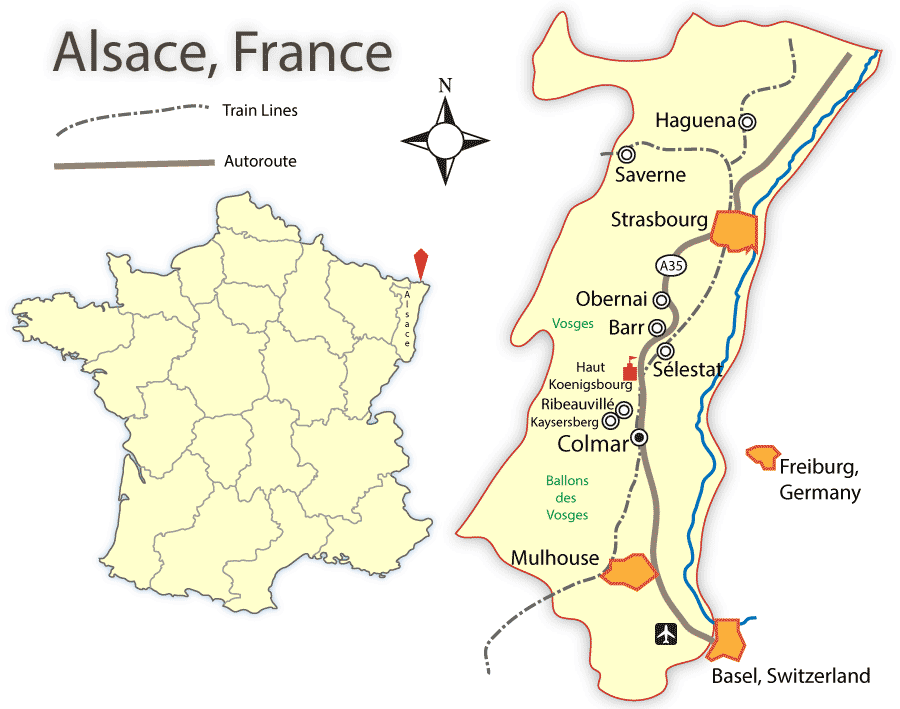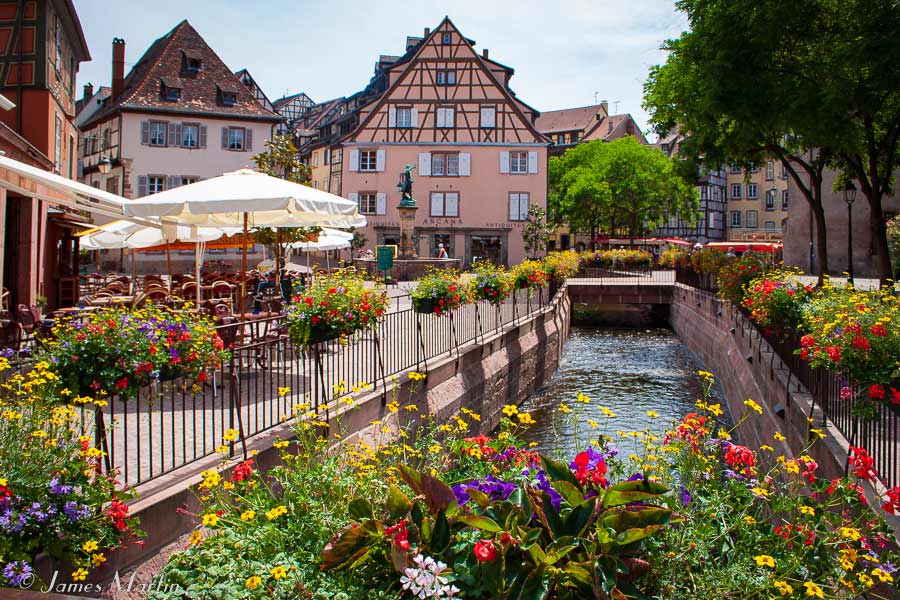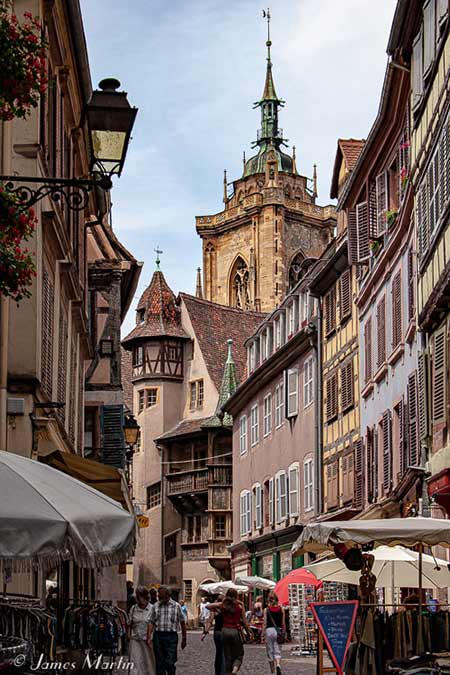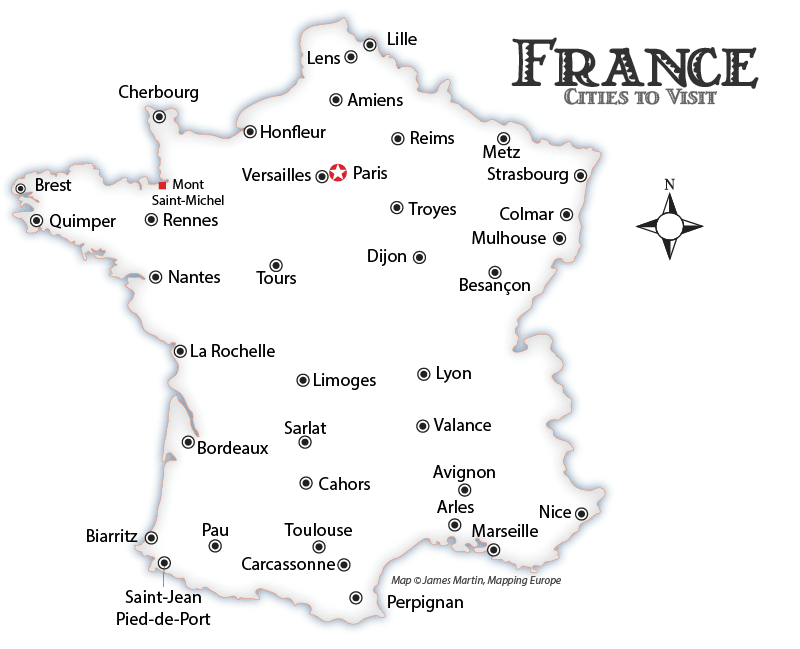Below is a map of the historic Alsace region of France, once the smallest French region, located in the northeast of France on the Border with Germany and Switzerland. Since 2016 the regions of Alsace, Lorraine, and Champagne-Ardenne were combined to form a larger region called Grand Est.
Below the map you'll find information on the most interesting cities and things to do in Alsace.

Alsace: Getting Your Bearings
Alsace is almost four times longer than it is wide; the historic region is bounded by the Rhine in the east and the Vosges mountains in the west. It is bounded by Germany and Switzerland on the east.
The A35 Autoroute links the larger cities of the Valley, and the train line parallels the autoroute. Between the highway and the foothills of the Vosges is the Alsace Wine Route, one of France's oldest with over 1000 wine producers represented. From April to October, villages organize wine and harvest festivals in turn.
The Larger Cities of Alsace
The three major cities of Alsace are Strasbourg, Colmar and Mulhouse. Outside of these cities, the region is very rural, with lots of small villages, vineyards, and castles to visit, as well as some large regional parks like Le Parc Naturel Régional des Ballons des Vosges, marked in green letters on the map.
Strasbourg and Colmar are both very interesting towns to visit. Colmar is smaller, "cuter" and more manageable. Some say it is the most beautiful city in Europe. Besides, it has lots of flowers, as you can see in the picture below.

Boat trips along Colmar canals are popular; don't miss the opportunity. Boats can be hired at La Krutenau at 1 rue de la Poissonnerie, Sweet Narcisse at 12a Rue de la Herse, and Les Bateliers de la Launch at Embarcadere Rue Turenne. Also not to miss: The Musée Unterlinden, a great museum of many different things housed in a former monastery.
Strasburg, the capital of Alsace, is not lacking in eye candy either. It can also be seen by boat at sea level, or by climbing the cathedral bell tower. The area called "Petite France" is Strasbourg's prettiest and most enchanting neighborhood. Getting between Strasburg and Colmar takes 50 minutes on the train.

Mulhouse might seem industrial to you at first, but as such it contains many "technical" museums, including the Cité de l'Automobile, a car museum that's a must for auto aficionados, and the French Railway Museum, called Cité du Train.
Saverne is on a mountain pass on the border with the region of Lorraine, and it is noted for the Chateau des Rohans, constructed in Neoclassic style at the end of the 18th century.
Selestat is a town of traditional Alsace buildings and interesting churches. It is on the Route des Vins (the Alsace Wine Route, see below) and a good base for exploring the Castle at Haut Koenigsbourg.
Getting to and Around Alsace on the Train
[Discloser: Content in this section contains affiliate links, from which we receive a small sum that allows us to bring this free content to you.]
The TGV Est links Strasbourg to CDG Airport in Paris; the ride takes less than 2 1/2 hours. EuroAirport Basel-Mulhouse-Freiburg is located between Mulhouse and Basel. Car rentals from Avis, Europcar, Hertz, National, and Sixt are available at the airport. Bus service is available to Strasbourg from the airport. You can Book TGV Tickets Online.
Weather in Alsace
Alsace, between the Vosges and the Rhine, has a fairly dry climate and relatively cold and harsh winters. In the wind shadow of the Vosges, Alsace has lower rainfall levels than the neighboring regions, and the area around Colmar is especially dry. To see historic climate and current weather conditions in Mulhouse, see Mulhouse Travel Weather and Climate.
Haut-Koenigsbourg, The King's Castle
Marked in red on the map, Haut-Koenigsbourg Castle sits high on a hill between Selestat and Ribeauville. Constructed in the 12th century and besieged during the Thirty Years War and burnt to the ground in 1633, the castle was restored by Wilhelm II between 1900 and 1908. Haut-Kœnigsbourg castle is 26 km north of Colmar, 55 km south of Strasbourg and 12 km west of Sélestat. Official Haut-Koenigsbourg web site in English.
Alsace Wine Route
The Alsace Route du Vin, or wine route, runs along the eastern foothills of the Vosages from just west of Strasbourg in the north to a point just west of Mulhouse. I suggest picking a place to stay near the midpoint around Colmar like Kaysersberg or nearby Riquewihr. You could easily rent a house or apartment to explore this fascinating countryside and take day trips into larger towns like Colmar.
Riquewihr is a very well preserved medieval city, with many old houses from the 16th and 17th centuries. There are lots of winstubs in both Kaysersberg and Riquewihr, in which you can taste the local wine. An interesting option for staying in Riquewihr is the Remparts de Riquewihr self-catering apartments.
Obernai is on the wine route, but it's also a beer destination. Kronenbourg is produced there.
Abundant trails through the vineyards in which the grape varieties are signed make an interesting diversion. There is a list of them here. Be aware the trails are sometimes closed in the months of the harvest to allow passage for vineyard workers.
Here is a list of the top events along the route.
As with other wine routes in Europe, the food along the route du vin is a notch above. Alsace is noted for its cuisine in general. A great guide for tourists is Alsatian Specialties: How to Read a Restaurant Menu in Alsace.
Intelligent Travel offers a nice article about the route: Secrets from the Alsace Wine Route: Fromage Pilgrimage.
Maginot Line in Alsace
For those interested in war memorials and World War II fortifications, lots of remnants of the Maginot line are still visible today. Volunteers run them, and many are only "open" on Sundays.
According to Wikipedia,
Maginot Line (French: Ligne Maginot), named after French Minister of Defense André Maginot, was a line of concrete fortifications, tank obstacles, artillery casemates, machine gun posts, and other defenses, which France constructed along its borders with Germany and Italy, in the light of experience from World War I, and in the run-up to World War II. Generally the term describes either the entire system or just the defenses facing Germany.
You can visit these not-very-effective trench warfare fortifications along the border with Germany. The Maginot Line monument and museum at Hatten is a 20 minute drive from Strasbourg. The Fortress Schoenenbourg has been restored and has one of the best Maginot Line museums.
Where to Stay in Alsace
If you are in Alsace for a leisurely vacation, you might wish to take advantage of the wine country atmosphere of rural Alsace and rent a vacation house or cottage. Our affiliate partner VRBO lists over 700 properties in Alsace, from city apartments to large rural farmhouses. In Strasbourg, for example, we'd prefer to stay in an area near the river called "Petite France" where you'll be in the heart of the historic city.

Getting Around Alsace and France: Trains, Planes, Buses and Carpools
Enter the places you want to go, and the widget below will show you all the transportation options available:
